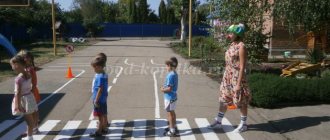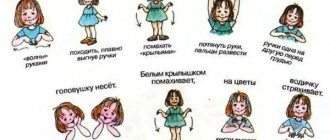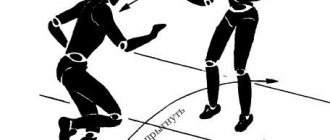Child safety in kindergarten
Our children are our future... This is a well-known truth, especially taking into account the social values of our state. But at the same time, we constantly hear about various emergencies that happen to children in certain educational institutions. Who is responsible for them? How and by whom is the safety of children ensured, for example, within the walls of kindergartens? Let's understand the material.
Who provides security and is responsible?
Kindergarten pupils have the right to protection of life and health during the educational process <*>. The responsibility to create a safe environment lies with the educational institution, i.e. on its employees, under whose control and supervision children are <*>. In kindergarten it is:
- a preschool teacher ( educator ), who is personally responsible for creating a safe environment when organizing the educational process. He must comply with the rules for protecting the life and health of children; established fire safety requirements, etc.; must know the basics of first aid;
- assistant teacher , who must know the rules and regulations for protecting the life and health of students; sanitary and hygienic standards for the maintenance of premises, equipment, inventory; first aid rules; fire safety rules and regulations, etc.
Note In practice, as a rule, for one group of pupils there are two teachers working in shifts and one assistant teacher. That is, direct control and supervision of children is carried out simultaneously by two people . At the same time, the teacher always bears personal responsibility for the children. Along with him, the assistant teacher is also responsible if the children remain only under his control, and at night in kindergartens with children staying around the clock, he bears full responsibility;
- the head of the kindergarten , who is responsible for the results of the activities of the educational institution; for life and health, respect for the rights and freedoms of children during the educational process; takes measures to create safe and favorable learning and upbringing conditions for children; ensures compliance with fire safety rules and regulations, etc.
Note! The following persons do not have the right to work with children: - those with a criminal record - until it is expunged or withdrawn; - those deprived of the right to engage in teaching activities; - those who have ever committed crimes against sexual integrity or sexual freedom or some others <*>; - those who have not passed preliminary preventive drug examination <*>.
Thus, as soon as you brought your child to kindergarten and handed him over to the teacher or his assistant, the kindergarten staff bears responsibility for your child. The child is in their area of responsibility until the moment when he returns under your direct control , i.e. when you are close to the child and can control him (for example, hold his hand).
Note: Situations are possible when a child sees his mother “on the horizon” and runs towards her; or they called him on the phone and said that they would pick him up soon, and the child went to the locker room to get dressed; or he himself decided that it was time to go home and left the group on his own. If something happened to him at this time (fell, hit, got hit by a car), responsibility will be borne by the persons under whose control and supervision the child was or should have been. In all the above situations, these are teachers and their assistants.
How security is ensured
The comprehensive safety of kindergarten students usually includes:
— fire safety measures;
— measures to ensure sanitary and epidemiological well-being;
— measures to ensure the safety of children’s lives and health;
— occupational health and safety measures;
— electrical safety measures;
— civil defense activities (training of administration and personnel);
— anti-terrorism security measures.
Authorized state bodies and organizations are responsible for compliance by the kindergarten administration with safety requirements in each of the listed areas (for example, education departments of district administrations, state fire inspection bodies, state sanitary inspections, internal affairs bodies, etc.). As part of their activities, they issue mandatory rules, instructions, regulations, etc. Compliance with these standards is verified through inspections and other activities. At the same time, in practice, it is quite difficult for parents to make sure that all these norms are actually observed.
However, parents also have other opportunities to influence the safety of children in kindergarten. Some measures and measures to ensure safety are not prescribed anywhere, but can be introduced by the head at the level of a particular kindergarten at the suggestion of parents or on their own initiative. It is desirable that these measures be implemented in a comprehensive manner. The reason for their introduction, as a rule, is various emergencies, news of which spreads quite quickly. Here are some of these measures.
Access mode or “trusted person system”
Only so-called authorized persons can pick up a child from kindergarten. And this is not just a circle of people whom the child has recognized and with whom he is ready to leave, for example, relatives, neighbors or acquaintances. First of all, such persons include the legal representatives of the child , i.e. his parents, adoptive parents, guardians, trustees <*>.
Note: In practice, there are cases when a teacher should check even a legal representative. For example, the child’s parents are divorced and the child permanently lives with his mother, who always picks him up. If the father suddenly comes to pick up the child, the teacher is advised to call the mother and find out if she allows the child to go with him.
Trusted persons, in turn, can entrust other persons, in particular grandparents, adult brothers and sisters, to pick up the child from kindergarten.
Note : In practice, as a rule, such trust is formalized by writing a power of attorney, which is given to the teacher along with a copy of the proxy’s passport and stored on the premises of the kindergarten.
In some kindergartens, a special pass is issued for each authorized person, without which they will not only not be given the child, but will not even be allowed into the territory of the kindergarten.
CCTV
This measure may help:
— to recreate the picture of the emergency that occurred, determine the culprit, and the location of the responsible persons;
— detect children left unattended;
— track the direction of the child’s movement if he left the kindergarten territory on his own;
- expel unauthorized persons from the territory of the kindergarten or identify them by image if they have committed illegal actions, etc.
At the same time, organizing competent video surveillance throughout the kindergarten is an expensive undertaking. Often educational institutions themselves cannot afford such expenses. Typically, parents of kindergarten students or, less commonly, other individuals purchase the necessary equipment as sponsorship. In addition, video cameras and other equipment must not only be installed, but also maintained.
Note: This measure is good if certain conditions are met, in particular: - cameras must always be in working order; - it is possible to view the image on any of the displays included in the system; - there is an employee on an ongoing basis authorized to monitor the image from the cameras (watchman , security guard);— camera recordings are stored on the server for a certain period of time;— it is possible to search for images by date and time of recording, as well as enlarge selected images or their fragments, print individual frames, etc.
Non-free entry and exit
This measure can prevent:
— the presence of unauthorized persons on the territory with unclear intentions;
- the appearance on the territory of the kindergarten of objects and things that can cause harm to the child (syringes, needles, firecrackers, lighters, broken glass, cans, etc.);
- walking dogs that can scare or bite children, etc.
This is implemented by installing locking devices at the entrances (doors, gates, gates) to the kindergarten. They are open only during the arrival and departure of pupils, usually from 7 to 9 and from 16 to 19 hours. In some gardens, entry is made by calling the gate, when a security guard (watchman) opens it remotely.
It also makes sense to install locking devices with a latching mechanism at the entrances to the kindergarten building. Then the door will open from the inside and outside after pressing a button, which is at the height of an adult. In this case, it is possible to prevent children from going outside unaccompanied by adults.
Preventive activities involving children
They are conducted by employees of the Ministry of Emergency Situations and the Department of Internal Affairs in the form of lectures and practical exercises for the benefit of children and adults. During events:
— will tell you about the rules for handling fire and flammable objects;
— will teach rules of behavior on the road and on the street;
— they will explain in an accessible form for children how not to get lost on the street and in the crowd, how to behave with strangers;
— remind adults about the dangers of leaving children unattended, etc.
These events are carried out both as part of our own actions and at the request of kindergarten administrations.
Useful gadgets
In the 21st century it is impossible not to take advantage of high technologies. Modern gadgets not only have entertaining, educational, and service functions, but they can also help in a dangerous situation or prevent this situation from happening.
For example, a smart children's watch with GPS will help:
— track the child’s movements throughout the day;
- make calls to him;
— fence off the area, when a child leaves it a notification will be sent;
- listen to what is happening around the child.
Also, the child himself can call his parents and talk on speakerphone or, by pressing the SOS button, notify about the danger. The undoubted advantage is that the watch is always with the child; it is not as easy to lose as a phone, because it is fixed on the wrist. In addition, the child himself will not be able to turn them off (according to the manufacturer), and some have a special sensor that will notify the parent when the watch is removed. These watches can be used from the age of 3 years.
Note: In dangerous situations, sometimes adults can become confused and not know what to do. Parents and kindergarten workers can be recommended to install the application “Ministry of Emergency Situations of Belarus: Help is Near” . It will help you navigate unusual situations (a child is lost or an adult is lost, a dog has bitten, there is smoke or the smell of gas, etc.). The “First Aid” section is equipped with audio prompts for first aid actions in the most common cases. It is also possible to call the Ministry of Emergency Situations using the “112” button from almost any page of the application.
Instructions on the rules of safe behavior for pupils of a preschool educational institution (kindergarten)
Kindergarten teachers need to study with their students instructions on the rules of safe behavior for preschool children in everyday life, public transport, when finding unfamiliar and dangerous objects, when communicating with strangers, on the street and in public places. Also, it is very important to explain to students the rules of behavior on water, on ice, with fire, during a thunderstorm and in the forest.
download: Documentation on Fire Safety in Preschool Educational Institutions 38 documents taking into account laws as of September 8, 2021!
32. Instructions on the safety rules for children at home (at home and in the yard) 33. Instructions on the rules for the safe behavior of children on the road 34. Instructions on the safety rules for children in public transport 35. Instructions on the safety rules for children at railway transport facilities 36. Instructions on rules for the safety of pupils at water transport facilities 37. Instructions for the safety rules for pupils when explosive objects and substances are detected 38. Instructions for the safety rules for pupils with strangers (in situations of violent behavior by adults) 39. Instructions for the prevention of criminal situations in the yard, on the street, at home and in public places 40. Instructions for the prevention of negative situations in public places 41. Instructions for the safety rules for students on ice 42. Instructions for the safety rules for students on the water 43. Instructions for the safety rules for students during thunderstorms and lightning 44. Instructions for the rules safety rules for pupils with fire 45. Instructions for the safety rules for pupils with animals and insects 46. Instructions for the safety rules for pupils with plants and mushrooms 47. Instructions for the safety rules for pupils when taking walks on the site 48. Instructions for the safety rules for pupils when taking walks in icy conditions 49. Instructions on the rules of safe behavior of children when conducting excursions, targeted walks with exit from the territory
download: Instructions for the catering unit (kitchen) Instructions for the catering unit of the School, preschool educational institution, Canteen, Restaurant, Cafe. Update: 09/05/2021








